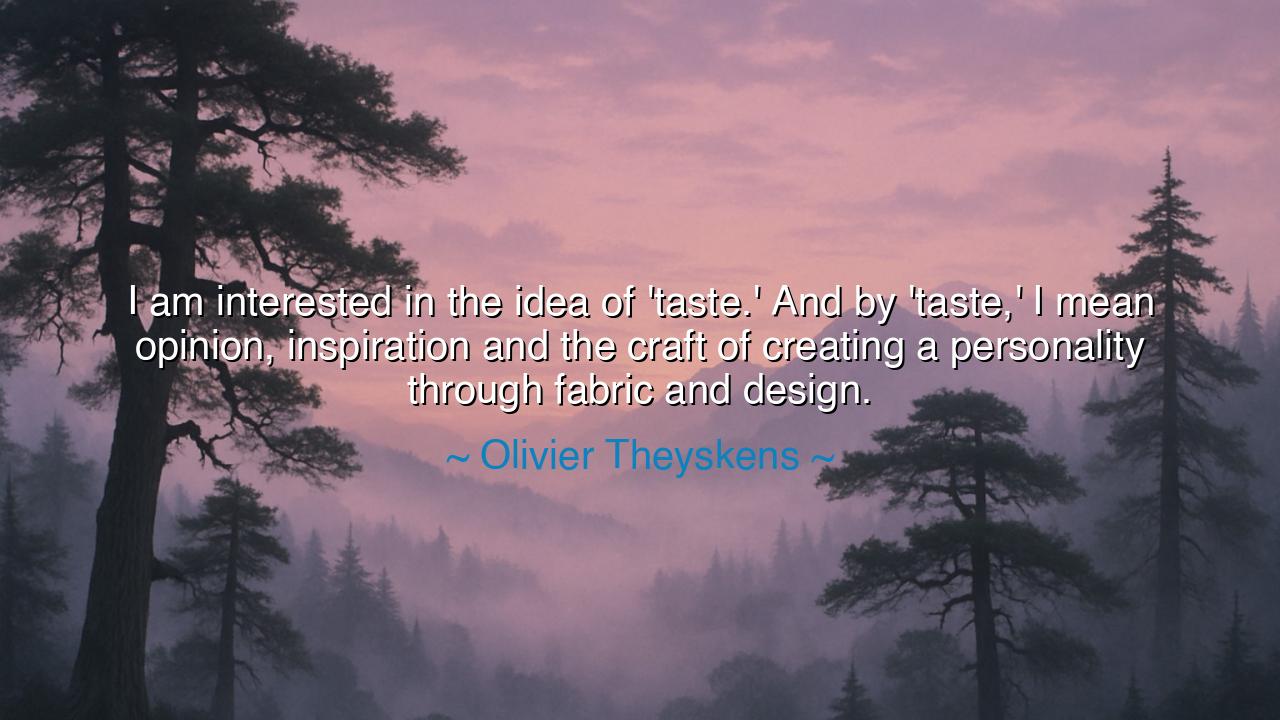
I am interested in the idea of 'taste.' And by 'taste,' I mean
I am interested in the idea of 'taste.' And by 'taste,' I mean opinion, inspiration and the craft of creating a personality through fabric and design.






In the words of Olivier Theyskens, a poet of fabric and silhouette, there arises a thought as refined as silk and as enduring as marble: “I am interested in the idea of ‘taste.’ And by ‘taste,’ I mean opinion, inspiration and the craft of creating a personality through fabric and design.” These words unveil not merely a reflection on fashion, but a meditation on the ancient art of self-expression. For Theyskens does not speak of “taste” as a matter of wealth or prestige, but as a sacred dialogue between the soul and the world — a craft of shaping identity, thread by thread, gesture by gesture, into something that reveals rather than conceals the truth of one’s spirit.
In the days of old, before the machines hummed and the markets overflowed with garments, clothing was a language. Kings were known by their robes, priests by their vestments, and warriors by the glint of their armor. To dress was to declare. The Greeks knew that aesthetic was not vanity, but the outer reflection of the inner harmony. The sculptor shaped marble to mirror the divine; the weaver shaped cloth to mirror the soul. Thus, when Theyskens speaks of taste, he revives this ancient understanding — that what we create and adorn ourselves with is not a mask but a mirror.
To possess taste, in his meaning, is to weave together three threads — opinion, inspiration, and craft. Opinion gives voice; it is the assertion of one’s individuality, the refusal to be silent in a world of imitation. Inspiration gives breath; it draws from beauty, memory, and dream, transforming what is seen into what is felt. Craft gives body; it is the hand’s devotion to form, the discipline that translates vision into substance. Together, these three form the holy trinity of creation, through which a person — or a designer — fashions not just garments but identity itself.
Consider Coco Chanel, who rose from orphaned poverty to become a sovereign of style. She defied the stiff corsets and ornate excess of her age, replacing them with simplicity, movement, and grace. To many, this was rebellion; to her, it was revelation. Her taste was not born from privilege but from conviction — from the belief that elegance lies not in decoration, but in freedom. She took the black dress, once a symbol of mourning, and turned it into the very emblem of sophistication. Her opinion challenged the world, her inspiration drew from modernity itself, and her craft transformed cloth into philosophy. Through fabric and design, she forged a personality — one that still breathes through time.
Theyskens’ words remind us that fashion, art, and all acts of creation are not mere indulgences, but sacred acts of becoming. To have taste is to know oneself — to know what one reveres, what one rejects, and what one aspires toward. It is to stand in a world of noise and still choose your own melody. The ancients called this “arete,” the pursuit of excellence in one’s form and function, a balance between inner truth and outer beauty. So too does true taste dwell not in following trends, but in expressing authenticity — in crafting the self with intention and love.
There is a quiet power in understanding this: that every choice, every texture, every line we wear or draw or build is a statement of character. When a person cultivates taste, they do not seek approval — they seek alignment between soul and substance. They learn that fabric can speak, color can console, and form can liberate. To shape beauty is to shape meaning, and to shape meaning is to shape destiny.
So let this be the lesson to those who listen: Cultivate your taste as you would cultivate your soul. Do not imitate; discern. Seek inspiration not from excess, but from essence. Practice your craft with patience, for the hand must serve the heart before it can master the world. And above all, dress your life — in fabric, in word, in deed — with intention. For style without spirit is empty, but taste guided by wisdom becomes art.
And when you walk forth each day, remember: your life is the fabric, your dreams the thread, and your choices the needle. Stitch them together with purpose, and let the garment of your being speak silently — yet eloquently — of who you are, and of what you aspire to become.






AAdministratorAdministrator
Welcome, honored guests. Please leave a comment, we will respond soon